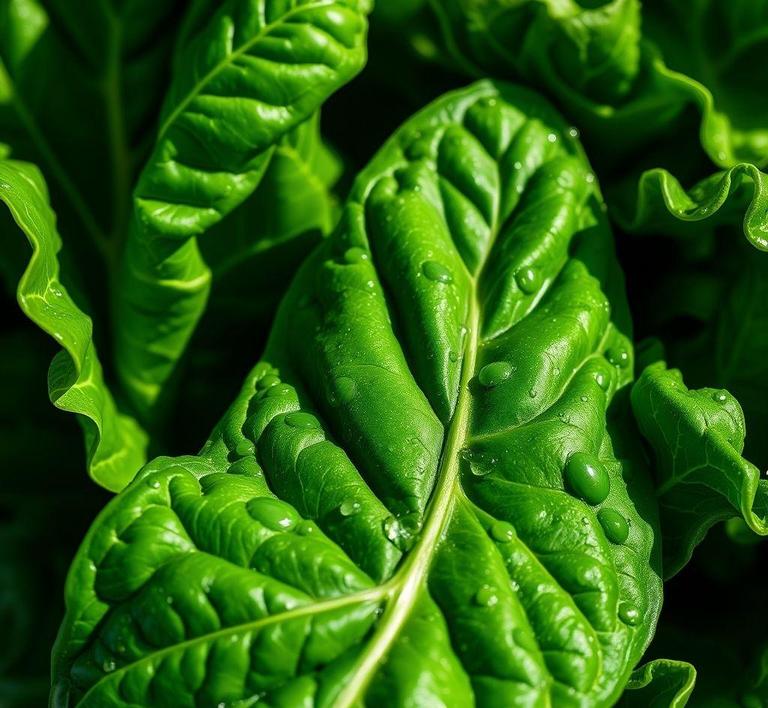If you’ve ever cooked up a big batch of collard greens and found yourself with leftovers, you might wonder, “Can I refreeze collard greens”? The good news is, yes, you can refreeze collard greens! However, there are a few things to keep in mind to preserve their flavor and texture. Whether you’ve already cooked them or just want to freeze them for later, this guide will walk you through the best practices for freezing and refreezing collard greens, so you can enjoy their delicious taste any time without compromising quality.
Can You Refreeze Collard Greens?

Collard greens, a staple in Southern cuisine, are known for their robust flavor and versatility in dishes such as stews, soups, and sautés. However, like many leafy vegetables, they are prone to spoilage if not properly stored. The question of whether you can refreeze collard greens comes up frequently in the context of preserving leftovers or taking advantage of bulk purchases. The answer is nuanced.
Technically, yes, you can refreeze collard greens, but there are important considerations that affect their texture, flavor, and overall quality after refreezing. Freezing collard greens is often done to preserve them for later use, as they have a short shelf life when fresh. However, once you thaw and reheat them, you are essentially setting up a cycle of thawing and freezing that can degrade the quality over time.
To understand whether it’s a good idea to refreeze collard greens, we need to think about the effects of freezing on leafy greens in general. When collard greens are frozen, their cell structure breaks down, causing them to lose moisture when thawed. This leads to a soggy texture when reheated, which is the primary downside of freezing and refreezing them.
The real issue arises when you freeze and then thaw collard greens, and then freeze them again. Each cycle exacerbates the breakdown of cellular structure and flavor loss, leading to a mushier, less vibrant final product. This process also increases the likelihood of freezer burn, which can make them unappetizing in taste and texture.
How To Refreeze Collard Greens?
If you decide that refreezing collard greens is necessary, such as after they’ve been cooked, it’s important to follow specific steps to ensure that you maintain the best possible quality, even if it may not be the same as fresh.
1. Thawing Process
Before attempting to refreeze collard greens, they must be thawed properly. The best method is to let them thaw slowly in the refrigerator. This allows the moisture in the greens to redistribute, reducing the chances of excess water causing a mushy texture. Avoid thawing them at room temperature, as this can lead to bacteria growth, especially since greens are highly perishable.
2. Blanching (For Fresh Collard Greens)
If you’re working with fresh collard greens, blanching them before freezing (even if you intend to freeze them multiple times) can make a difference. Blanching involves briefly boiling the greens for a few minutes and then cooling them rapidly in ice water. This process helps to preserve color, flavor, and nutritional content. After blanching, make sure to dry the collard greens thoroughly before freezing.
3. Packing For Refreezing
When preparing collard greens for refreezing, make sure that the greens are tightly packed in freezer-safe bags or containers. Removing as much air as possible helps to prevent freezer burn. Vacuum-sealing is an ideal method, as it eliminates air from the packaging, but if you don’t have a vacuum sealer, pressing out air manually from freezer bags will suffice.
4. Freezing In Portions
Freezing collard greens in smaller portions is a great strategy for refreezing. This way, you can defrost only what you need, preventing the need to repeatedly thaw and refreeze large quantities. Portioning also makes it easier to preserve their quality since smaller batches thaw more quickly and evenly.
5. Quick Freezing
Once packed, place your collard greens in the coldest part of your freezer. The quicker they freeze, the better their texture will be when thawed. If you’re freezing large amounts, it’s best to spread the greens in a single layer on a baking sheet to speed up the freezing process before transferring them to bags or containers.
Quality Impact
Refreezing collard greens can have a noticeable impact on their quality, primarily affecting texture, flavor, and nutritional value.
1. Texture
One of the most significant issues with refreezing collard greens is the change in texture. The cell walls of leafy vegetables, like collard greens, are filled with water. When frozen, the water inside the cells turns to ice, which expands and ruptures the walls. As a result, once thawed, the collard greens become limp, soggy, and mushy. Freezing them again after this process only worsens the breakdown of their structure, leading to a much less appealing texture when reheated.
After refreezing, collard greens might become so soft that they lose their original vibrant, crisp texture, making them less suitable for salads or as a garnish. However, they are still perfectly usable in soups, stews, or casseroles, where the texture won’t be as noticeable.
2. Flavor
Freezing can cause a slight loss in flavor because the natural enzymes and cellular structures that give collard greens their fresh, earthy taste begin to break down when frozen. When refrozen, the flavor diminishes even further. Additionally, if you freeze collard greens in a less-than-airtight container, freezer burn can develop. This causes the greens to have a stale or off taste, further compromising their appeal.
However, when cooked into dishes with other strong flavors like garlic, onion, or smoked meats, these changes in flavor may be less perceptible.
3. Nutritional Value
Freezing and refreezing may cause a slight loss of nutrients, particularly vitamin C and some B vitamins, which are sensitive to temperature changes. The longer the greens are frozen, the more nutrient degradation can occur. However, refreezing them once will not dramatically alter their nutritional content in comparison to their original state, so you can still enjoy most of the vitamins and minerals when cooked.
4. Freezer Burn
If collard greens are not properly stored in an airtight container, they are more prone to freezer burn during refreezing. Freezer burn occurs when air comes into contact with the surface of the food, causing dehydration and the formation of ice crystals. This will make the greens look discolored (often a pale or frosty appearance) and taste dry or bland. Freezer burn isn’t harmful, but it can make your collard greens less palatable.
While it is technically possible to refreeze collard greens, it comes with a few significant caveats. Each cycle of freezing and thawing damages the texture, reducing the leafy greens to a limp, soggy state that is far from their fresh, crisp original texture. The flavor can also become muted, and if not properly stored, freezer burn can lead to a less-than-pleasant taste.
If you choose to refreeze collard greens, it’s crucial to handle them with care-blanching, quick freezing, and proper packaging are key steps to minimize quality loss. While they may still be usable in soups, stews, or casseroles, refrozen collard greens are unlikely to hold up well in dishes where their texture and fresh flavor are more important, such as salads or as a standalone side dish.
Ultimately, while you can refreeze collard greens, it is always best to limit the number of times they are frozen and thawed to preserve their quality as much as possible. For the best results, try to use up frozen collard greens in a reasonable timeframe and only thaw what you plan to consume.
Is It Safe To Refreeze Collard Greens?
Refreezing collard greens-just like other leafy vegetables-can be a bit of a tricky process, especially when you’re trying to preserve both the taste and nutritional value of the greens. The simple answer to whether it is safe to refreeze collard greens depends on a few factors, primarily the condition in which the greens were initially frozen, thawed, and stored.
When collard greens are frozen, the water content within the leaves turns to ice. If the greens are thawed and then refrozen, the ice crystals can break down the structure of the leaves, resulting in a mushier texture. This is particularly problematic with collard greens, as they are already dense and fibrous to begin with. Refreezing them can intensify the loss of texture, making them less enjoyable when cooked. Additionally, there’s a concern about the growth of bacteria or the degradation of nutrients, especially if the greens were thawed improperly or kept at unsafe temperatures for too long.
However, if the greens were frozen initially under optimal conditions (i.e., immediately after blanching, sealed properly in airtight containers or freezer bags, and stored at a consistent temperature of 0°F or lower), refreezing is technically safe in the sense that it won’t cause immediate food safety issues. The primary risk lies in the quality and texture of the collard greens after they’ve gone through multiple cycles of freezing and thawing. To ensure safety, always make sure that the greens are not left at room temperature for extended periods when thawing.
Signs That Collard Greens Should Not Be Refrozen
Knowing when not to refreeze collard greens is just as important as understanding the proper way to do it. There are several telltale signs that collard greens have deteriorated to the point where refreezing is not advisable:
- Excessive Wilting or Softness: If the collard greens have already become limp or overly soft upon thawing, they have likely started to lose their structural integrity. Refreezing will only exacerbate this issue, leading to an unpleasant mushy texture that won’t improve with cooking.
- Discoloration: Fresh collard greens are vibrant and deep green in color. If the greens have started to turn yellow or brown, this indicates that they may have been exposed to heat or air for too long. Discoloration can also be a sign of spoilage, which makes them unsafe to eat or refreeze.
- Off Odors: If the collard greens emit a sour or unpleasant odor when thawed, this is a clear indication that they have begun to spoil. Spoiled greens may contain harmful bacteria, and refreezing them would not only be a poor choice for taste but could also pose a health risk.
- Excess Water or Ice Crystals: If there is significant water pooling in the container, or if the greens are surrounded by large ice crystals, this indicates that they were not sealed properly when frozen. This moisture loss will degrade the quality further upon refreezing.
- Freezer Burn: Freezer burn appears as discolored patches (often white or greyish) on frozen food and occurs when the food has been exposed to air within the freezer. If the collard greens are showing signs of freezer burn, refreezing them may worsen the texture and flavor.
Common Refreezing Mistakes
When it comes to freezing and refreezing collard greens, there are several common mistakes that people make, which can compromise both the quality and safety of the greens:
- Improper Thawing: The most common mistake is letting collard greens thaw at room temperature, which can cause them to spend too long in the temperature danger zone (between 40°F and 140°F). Bacteria thrive in this range, and thawing this way could lead to contamination. The safest way to thaw frozen greens is in the refrigerator or using a quick-thaw method, like placing them in a sealed bag in cold water.
- Not Blanching Before Freezing: One of the biggest mistakes is freezing collard greens without blanching them first. Blanching (briefly boiling or steaming the greens and then plunging them into ice water) helps preserve the color, texture, and flavor of the collard greens. It also helps kill enzymes that can cause the greens to lose quality during freezing. Skipping this step results in a less than ideal frozen product.
- Refreezing After Thawing Partially: Sometimes, we may thaw just a portion of frozen collard greens, but rather than using them up, we might decide to refreeze the remaining portion. This is a mistake, as partially thawed greens can be a breeding ground for bacteria. Once greens are thawed, they should either be cooked or discarded. Avoid refreezing if you’ve taken them out of the freezer and allowed them to thaw.
- Overpacking the Freezer: If collard greens are packed too tightly in the freezer, air circulation is restricted, and the temperature may not stay consistent. This can result in uneven freezing and a decrease in quality when thawed. Instead, freeze greens in a single layer before transferring them to a sealed container for longer-term storage.
- Not Using Airtight Packaging: Oxygen can degrade frozen greens, causing freezer burn and loss of flavor. If the greens aren’t wrapped tightly enough in a vacuum-sealed bag or freezer-safe container, air can reach the surface of the leaves, which compromises both texture and taste.
Tips And Tricks For Freezing And Refreezing Collard Greens
If you want to maximize the quality of your collard greens, here are some helpful tips and tricks:
- Blanch Before Freezing: Blanching collard greens is essential to preserve their color and nutrients. Place the greens in boiling water for about 3-4 minutes, then transfer them to ice water immediately to stop the cooking process. Afterward, pat them dry before packing them for freezing.
- Use Vacuum Sealing: For the best long-term storage, use a vacuum sealer to remove air from the bags. This prevents freezer burn and helps the greens stay fresh for longer.
- Label and Date: Always label your freezer bags with the date you froze the collard greens. While frozen foods are safe indefinitely, they are best used within 10-12 months to ensure peak flavor and texture.
- Small Portions: Freeze collard greens in small, meal-sized portions. This way, you only need to thaw what you will use at one time, reducing the temptation to refreeze and preserving the quality of the remainder.
- Quick-Thaw in Cold Water: If you do need to thaw your frozen collard greens quickly, place the bag in cold water (not hot water, as this can start cooking the greens). This method helps maintain the texture of the leaves, as opposed to microwaving or leaving them out at room temperature.
- Cooked Collard Greens: If you want to refreeze cooked collard greens, ensure they are completely cooled before sealing them in airtight containers. Avoid refreezing cooked greens multiple times to preserve both their texture and flavor.
Conclusion
Refreezing collard greens is possible but not always ideal. While it may not pose an immediate health risk if done properly, the quality of the greens can diminish with each freeze-thaw cycle. To ensure the best flavor and texture, it’s recommended to freeze collard greens only once after blanching, and to avoid refreezing them if they show signs of spoilage or deterioration. Proper storage and thawing methods are essential for maintaining the integrity of collard greens, so be mindful of how you handle them before and after freezing.
Ultimately, while refreezing isn’t always a complete disaster, it is best to be cautious and avoid doing it whenever possible. By following the proper freezing techniques, you can enjoy fresh, flavorful collard greens long after they’ve been harvested.


